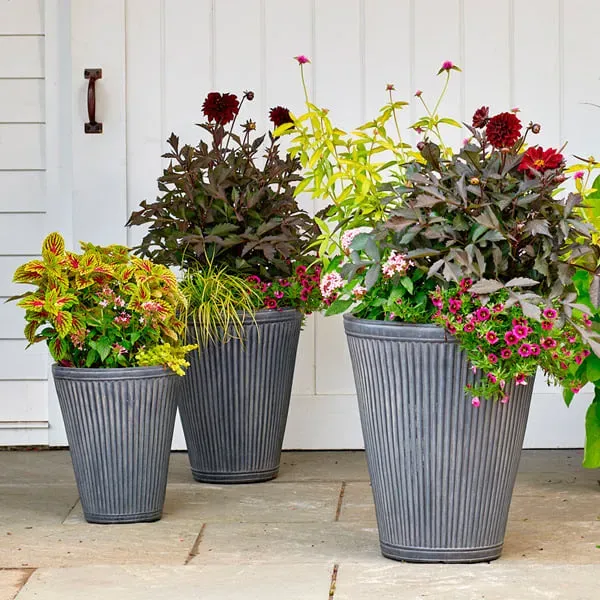Table of Contents
Landscape lilies are a popular choice among gardeners due to their beautiful blooms, fragrance, and low-maintenance requirements. They can add a touch of elegance and sophistication to any garden, making them a great addition to any outdoor space. At lilyflower.homes, we're passionate about helping you create a stunning garden that you'll love spending time in. In this article, we'll take a closer look at the world of landscape lilies, including how to choose the right type, how to care for them, and how to troubleshoot common problems. Whether you're a seasoned gardener or just starting out, this article will provide you with the knowledge and inspiration you need to grow beautiful landscape lilies in your own garden.

Learn The Ultimate Guide To Landscape Lilies: 7 Essential Tips
The Role of Landscape Lilies in Garden Design

The Role Of Landscape Lilies In Garden Design
Adding a Pop of Color and Texture
Landscape lilies aren't just pretty faces; they're design powerhouses! Think of them as the exclamation points in your garden's sentence. A burst of vibrant color here, a graceful curve of stems there – they add visual interest that keeps the eye moving and engaged. I love how they can transform a dull corner into a vibrant focal point. For instance, imagine a border of deep crimson lilies contrasting with the silvery foliage of artemisia. It's a stunning combination! You can even use them to create a sense of depth and movement, leading the eye through different areas of your garden. It's like a secret garden experience, unfolding one bloom at a time.
Want to learn more about making your lilies bloom even more beautifully? Check out our guide on flowering tips!
Lily Color | Suggested Garden Style |
|---|---|
Bright Yellow | Cottage Garden, Sunny Border |
Deep Purple | Formal Garden, Shaded Area |
Pure White | Moon Garden, Victorian Garden |
Creating Height and Visual Interest
Lilies are like vertical lines in a painting, adding height and dimension to your garden's composition. Taller varieties can act as backdrops for shorter plants, creating layers of interest and texture. Visualize this: towering Oriental lilies in the back, with cheerful daylilies and low-growing groundcover in the front. It's a symphony of heights and colors! You can also use different lily varieties to create a sense of rhythm and repetition, leading the eye through the garden in a pleasing way. I find that mixing heights really brings a garden to life.
For more tips on choosing the perfect lily for your garden, take a look at our post on choosing the right bulb size.
Designing with Lily Variety and Bloom Time
One of the coolest things about landscape lilies is the sheer variety! From tiny, delicate blooms to massive, showy flowers, there's a lily for every taste and garden style. And they don't all bloom at once. By carefully selecting varieties with different bloom times, you can ensure a continuous show of color throughout the growing season. Imagine starting with early-blooming Asiatic lilies in spring, followed by the graceful trumpets in summer, and finishing with the fragrant Orientals in late summer or early fall. It's like having a different garden show every month! Plus, you can use this to your advantage when planning your garden design.
- Choose lilies with varying heights for a layered look.
- Select lilies with complementary colors to create a harmonious palette.
- Consider the bloom time to ensure continuous flowering.
Choosing the Right Type of Landscape Lilies for Your Garden

Choosing The Right Type Of Landscape Lilies For Your Garden
Lily Variety 101: A Crash Course
I know choosing the right type of landscape lilies can feel overwhelming, especially if you're new to gardening. But trust me, with a little knowledge, you'll be a pro in no time! There are several types of lilies to choose from, including Asiatic, Oriental, Trumpet, Candidum, Martagon, and Tiger lilies. Each type has its unique characteristics, growth habits, and bloom times. For example, Asiatic lilies are known for their bright colors and early bloom time, while Oriental lilies are famous for their large, fragrant blooms.
When selecting a type of lily, consider the amount of sunlight your garden receives, the soil type, and the desired bloom time. Some lilies, like Asiatic and Trumpet, prefer full sun to partial shade, while others, like Candidum and Martagon, prefer partial shade to full shade. Also, think about the mature size of the lily and leave enough space for it to grow.For more information on bulb sizes and how to choose the right one for your garden, check out our post on .
Lily Type | Characteristics | Bloom Time |
|---|---|---|
Asiatic Lily | Bright colors, early bloom time | Early summer |
Oriental Lily | Large, fragrant blooms | Mid to late summer |
Trumpet Lily | Large, trumpet-shaped blooms | Mid to late summer |
Thinking About Your Garden's Style and Theme
When choosing landscape lilies, think about your garden's style and theme. Do you have a formal or informal garden? Do you prefer bright and bold colors or soft and pastel shades? Considering your garden's style and theme will help you choose the right type of lily that will complement your garden's beauty.
For example, if you have a formal garden, you may want to choose lilies with a more structured and simple appearance, like Oriental or Trumpet lilies. On the other hand, if you have an informal garden, you may prefer lilies with a more relaxed and natural look, like Asiatic or Tiger lilies.
- Formal garden: Oriental, Trumpet, or Candidum lilies
- Informal garden: Asiatic, Tiger, or Martagon lilies
- Bright and bold colors: Asiatic or Tiger lilies
- Soft and pastel shades: Oriental or Trumpet lilies
For more tips on choosing the right lily for your garden's style and theme, check out our post on choosing the right flower color.
How to Care for Your Landscape Lilies

How To Care For Your Landscape Lilies
Watering Wisdom: Keeping Your Lilies Happy
Watering's key – think of your lilies like thirsty toddlers. They need regular drinks, especially during hot spells. But don't drown them! Soggy roots are a lily's worst nightmare. Water deeply at the base of the plant, avoiding getting the leaves wet. This prevents fungal diseases, which are lily's sworn enemies. I usually water mine deeply once or twice a week, depending on the weather. A good rule of thumb is to feel the soil – if it's dry a couple of inches down, it's time for a drink. Remember, consistency is crucial. Don't let them dry out completely, but also don't let them sit in a puddle. It's a delicate balance, like a tightrope walk. But once you get the hang of it, it's a breeze!
For more detailed instructions, check out our guide on watering lilies.
Watering Frequency | Soil Condition | Weather Condition |
|---|---|---|
Once a week | Moist but not soggy | Mild weather |
Twice a week | Slightly dry | Hot and sunny weather |
Less often | Moist | Cloudy and cool weather |
Feeding Frenzy: Nourishing Your Lilies
Lilies are hungry plants! They need regular feeding to produce those stunning blooms. I use a balanced, slow-release fertilizer in spring, before new growth appears. Think of it as giving them a strength-up for the growing season. Then, I'll give them a boost of liquid fertilizer every couple of weeks during the blooming period. It's like giving them a mid-season snack. Don't overdo it though; too much fertilizer can burn their roots. Always follow the instructions on the fertilizer package. It's better to under-fertilize than to over-fertilize. I've learned that the hard way – trust me, burnt roots are not pretty! And remember, healthy soil is the foundation of healthy lilies. You can improve your soil by adding compost or other organic matter. For more on soil care, check out our guide on soil requirements.
Need help choosing the right fertilizer? See our post on fertilizers for lilies.
- Use a balanced fertilizer in spring.
- Give a liquid feed every couple of weeks during blooming.
- Avoid over-fertilizing.
- Improve soil health with compost.
Common Problems and Solutions for Growing Landscape Lilies

Common Problems And Solutions For Growing Landscape Lilies
Okay, so you've planted your gorgeous landscape lilies, and you're picturing a breathtaking garden. But what if things don't go exactly to plan? Don't panic! I've been there. Gardening, especially with lilies, is like a rollercoaster – lots of ups and downs. One of the biggest issues I've faced is pests. Slugs and snails are lily's worst enemies, munching on their leaves and buds. I've had to wage war against them, using slug pellets and beer traps (yes, beer traps!). It's a constant battle, but worth it for those beautiful blooms. For more on pest control, check out our guide on pest control.
Another common problem is diseases. Lilies are susceptible to fungal diseases, especially if they're not getting enough air circulation or if the leaves are wet. Proper watering is crucial here – remember to water at the base of the plant, avoiding the leaves. Good air circulation helps too. If you notice any signs of disease, like brown spots or wilting, you might need to use a fungicide. We have some tips on that here. Prevention is key though – healthy plants are less likely to get sick. It's like taking your vitamins; it keeps you strong!
Problem | Solution |
|---|---|
Pests (slugs, snails) | Slug pellets, beer traps, handpicking |
Fungal diseases | Good air circulation, proper watering, fungicides |
Poor drainage | Amend soil with compost, raised beds |
Poor drainage is another common issue. Lilies hate soggy feet, just like us! If your soil doesn't drain well, the roots can rot. To fix this, you can amend your soil with compost or other organic matter to improve drainage. You could also try planting your lilies in raised beds. For some extra tips on soil, check out our page on .
Sometimes, lilies just don't bloom as much as you'd like. This could be due to several factors, including insufficient sunlight, poor soil fertility, or improper watering. Make sure your lilies are getting enough sun (check our sunlight needs guide) and that the soil is rich in nutrients. Remember that regular feeding helps, too – it's like giving them a little extra energy boost. You might also consider mulching around the base of the plants to help retain moisture.
- Insufficient sunlight: Move to a sunnier spot or prune nearby plants.
- Poor soil fertility: Amend with compost or fertilizer.
- Improper watering: Water deeply and consistently.
Finally, remember that lilies, like all plants, need winter care. In colder climates, you might need to mulch around the base of the plants to protect them from freezing temperatures. For those cold weather warriors, we have some winter care advice on winter care.
Dealing with these problems is all part of the gardening experience. It's about learning, adapting, and celebrating the small victories. Remember, even experienced gardeners face challenges – it's all part of the fun!
"Gardening is not just a hobby, it's a progression of discovery and learning." - Unknown Gardener.
Final Thought
Landscape lilies are a versatile and beautiful addition to any garden. With the right care and attention, they can thrive and provide a stunning display of color and fragrance. By following the tips and advice outlined in this article, you can enjoy the many benefits of landscape lilies in your own garden. Remember to choose the right type of lily for your climate and soil type, provide regular care and maintenance, and troubleshoot any common problems that may arise. Happy gardening!